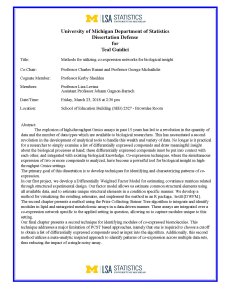Presented By: Department of Statistics Dissertation Defenses
Dissertation Defense: Methods for utilizing co-expression networks for biological insight
Teal Guidici

The explosion of high-throughput Omics assays in past 15 years has led to a revolution in the quantity of data and the number of data types which are available to biological researchers. This has necessitated a second revolution in the development of analytical tools to handle this wealth and variety of data. No longer is it practical for a researcher to simply examine a list of differentially expressed compounds and draw meaningful insight about the biological processes at hand; these differentially expressed compounds must be put into context with each other, and integrated with existing biological knowledge. Co-expression techniques, where the simultaneous expression of two or more compounds is analyzed, have become a powerful tool for biological insight in high-throughput Omics settings.
The primary goal of this dissertation is to develop techniques for identifying and characterizing patterns of co-expression.
In our first project, we develop a Differentially Weighted Factor Model for estimating covariance matrices related through structured experimental design. Our factor model allows us estimate common structural elements using all available data, and to estimate unique structural elements in a condition specific manner. We develop a method for visualizing the resulting estimates, and implement the method in an R package, \texttt{DWFM}.
The second chapter presents a method using the Prize Collecting Steiner Tree algorithm to integrate and identify modules in lipid and untargeted metabolomic assays in a data-driven manner. These assays are integrated over a co-expression network specific to the applied setting in question, allowing us to capture modules unique to this setting.
Our final chapter presents a second technique for identifying modules of co-expressed biomolecules. This technique addresses a major limitation of PCST based approaches, namely that one is required to choose a cutoff to obtain a list of differentially expressed compounds used as input into the algorithm. Additionally, this second method utilizes a meta-analytic inspired approach to identify patterns of co-expression across multiple data sets, thus reducing the impact of a single noisy assay.
The primary goal of this dissertation is to develop techniques for identifying and characterizing patterns of co-expression.
In our first project, we develop a Differentially Weighted Factor Model for estimating covariance matrices related through structured experimental design. Our factor model allows us estimate common structural elements using all available data, and to estimate unique structural elements in a condition specific manner. We develop a method for visualizing the resulting estimates, and implement the method in an R package, \texttt{DWFM}.
The second chapter presents a method using the Prize Collecting Steiner Tree algorithm to integrate and identify modules in lipid and untargeted metabolomic assays in a data-driven manner. These assays are integrated over a co-expression network specific to the applied setting in question, allowing us to capture modules unique to this setting.
Our final chapter presents a second technique for identifying modules of co-expressed biomolecules. This technique addresses a major limitation of PCST based approaches, namely that one is required to choose a cutoff to obtain a list of differentially expressed compounds used as input into the algorithm. Additionally, this second method utilizes a meta-analytic inspired approach to identify patterns of co-expression across multiple data sets, thus reducing the impact of a single noisy assay.
Explore Similar Events
-
Loading Similar Events...
